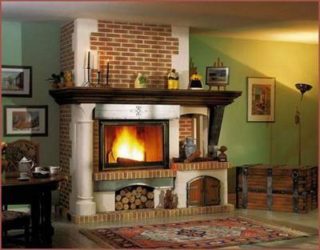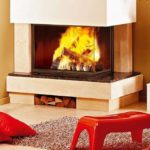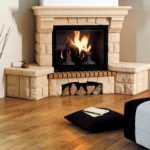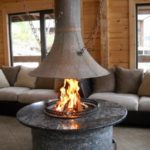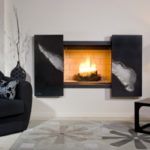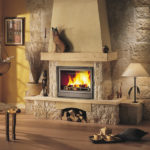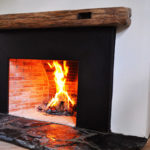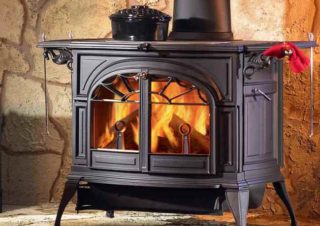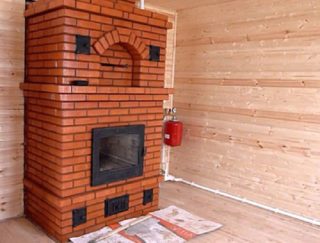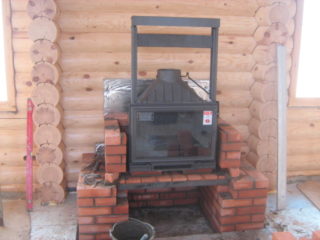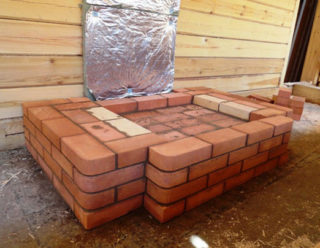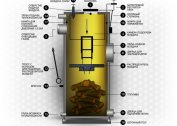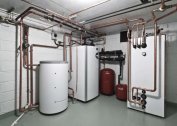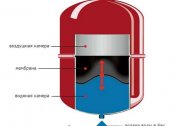Fireplaces are always associated with the comfort and warmth of a home. At all times, it served as a decoration for housing and provided the necessary temperature conditions. Therefore, the owners of private cottages do not refuse the opportunity to supplement the interior with a wood fireplace.
Design features
The equipment design consists of two main parts and several components of the system. The firebox, in which firewood is stacked, and the chimney that displays combustion products outside the premises are supplemented by the following elements:
- a portal for a wood fireplace;
- smoke collector in an open-hearth furnace for removing combustion products into a pipe;
- grate, necessary for laying firewood;
- an ashpit for collecting ash;
- smoke tooth to protect the room from smoke and cold air.
- grate designed for laying logs.
The complete design ensures reliable and safe operation of the product.
Advantages and disadvantages of wood fireplaces
Fireplaces for home wood have some features:
- act as a heating element during the cold season;
- create comfort and coziness;
- save money in comparison with electric heating;
- with a quality installation they last a long time.
Along with the positive properties, there are also disadvantages. These include the possibility of installation only in a private house and the need for periodic cleaning of the chimney.
Types of wood fireplaces at the location
Different layouts require the selection of the optimal configuration of fireplaces for the home. By location relative to the walls of the product there are:
- angular;
- island
- near the wall;
- embedded.
- Wall
- Angular
- Island
- Built in
There is an additional modification - wall-corner. They are widely used in ready-made rooms.
Corner wood-burning fireplace saves free space, which is important for small rooms. Flames are visible from anywhere in the room.
Separate fireplaces are located in the center of the room. Near them should be placed as carefully as possible interior items and furniture. The distance to the fire should be at least a meter.
Finished wood-burning fireplaces are mounted on the facade. Wall models are available in various forms. The main advantage is the ability to install in an already residential area. The fireplace block is located outside the wall.
Built-in models are mounted in a wall opening, therefore, they require decoration of a part that can be seen in another room. Usually a false wall is created for this purpose.
Built-in fireplaces are recommended for large areas. Under them, you must have space in the wall and chimney. Therefore, such models cannot be installed in a finished building.
Design Features
By design, fireplaces can be divided into several groups:
- closed;
- half open;
- open.
- Closed
- Open
- Half open
Each category has design features and a different installation method.
Closed
A hearth with a closed firebox is mounted in the main wall in such a way that its rear part is inside it. A drawing of a wood fireplace is created before the construction of the frame of the house begins.
Half open
A semi-closed firebox is usually characteristic of models that are mounted to the wall. They lack one or two surfaces of the structure.By thermal characteristics, this option is inferior to fireplaces with a closed firebox. Semi-open models are angular and wall.
In form are issued:
- rectangular;
- trapezoidal;
- irregular shapes with protrusions.
Semi-open models are the most popular, since they do not require complicated installation and are less fire hazard than with an open firebox.
Open
Models of country fireplaces with an open type of firebox are usually not in contact with the walls of the room. They can be mounted on suspensions or light supports, therefore they are often used for zoning large rooms.
An open wood fireplace has a more aesthetic function; it is not practical to use it for heating. He needs a chimney, which is located on top. An apartment is not a suitable place for such a product.
Types of wood fireplaces for the main materials
Fireplaces are made of various materials. The most popular: cast iron, steel and brick.
Made of cast iron
The cast-iron fireplace does not require decoration, thanks to the aesthetic appearance. It has several advantages:
- high degree of heat storage;
- a variety of complex shapes and sizes;
- resistance to high temperatures and mechanical stress;
- ease of maintenance;
- long service life.
They can act as the main element of heating a building.
Brick
Masonry requires the skills of professionals. The main design feature is installation at the construction stage of the building. They cannot be installed on the wooden floor; a separate foundation is necessary. The best place to install is a summer house or a country house. Not only a product for the home, but also a street wood fireplace is made of brick.
Of steel
Steel wood-burning fireplaces for a private home are more affordable and lighter in weight. The features of such models are the rapid heating and cooling of the housing, as well as the possible deformation of the structure during operation.
As a spectacular decorative interior item, glass fireplaces for the home are used. They are suitable for classic style and hi-tech.
Ways to increase heat transfer
To increase heat transfer, several rules must be observed:
- Promptly remove ash.
- Carry out maintenance annually.
- Close the shutter. When the source is idle, it must be blocked so that warm air does not go into the chimney.
- Use only well-dried firewood.
There are several technical devices that can increase heat transfer:
- water circuit - radiator block;
- heat accumulating devices;
- organization of forced convection;
- insert insert.
Their action is aimed at improving fire and maintaining heat.
How to make a fireplace with your own hands
If making a fireplace for your home with your own hands seems to be a more acceptable option, you can take advantage of the variety of decorative materials on the market. Since the built-in models should be built together with the building itself, it is better to choose wall-mounted structures.
To carry out construction work, you will need the following materials:
- refractory and ceramic bricks;
- mortar for masonry structures and foundations;
- ruberoid cut;
- boards for the arrangement of formwork;
- lattice;
- blew;
- metal door and shutter;
- rods and wire;
- asbestos cord.
To begin the manufacture of an outdoor wood fireplace should be the choice of location and development of the project. It should be a draft-proof corner, far from doors and windows.The first stage of construction is the creation of a solid foundation of cement-sand mixture and crushed stone.
On the surface of the floor should be laid roofing material for waterproofing. Then the prepared mixture is laid on it and dried. The next step will be laying the site out of fire-resistant bricks to minimize the likelihood of a fire.
The laying of the structure itself begins with the first row, called the hearth. The next row is stacked taking into account the need to install an ash pan and a blower. Using a wire from the outside of the door frame, the stove tape is fixed.
The next step is to create a firebox. Its edges should not be in contact with the external masonry, so they should be laid with basalt cardboard.
The screed over the door is installed using the corners to improve the appearance of the finished product. Particular attention should be paid to creating a chimney casing. It not only acts as a decorative element, but also carries a functional load.
Wood fireplaces are durable, aesthetic and easy to maintain, so they do not lose relevance for many years. Live fire cannot be replaced by any high-tech imitation.
